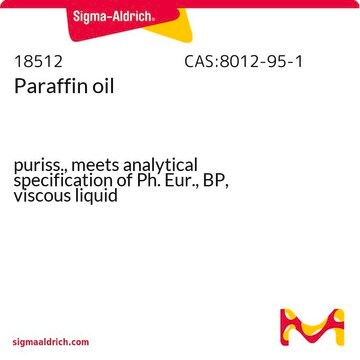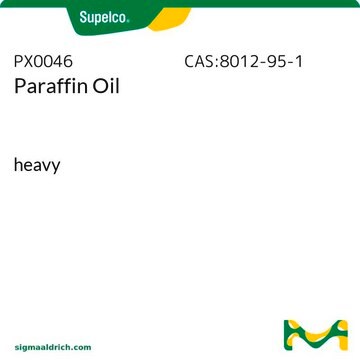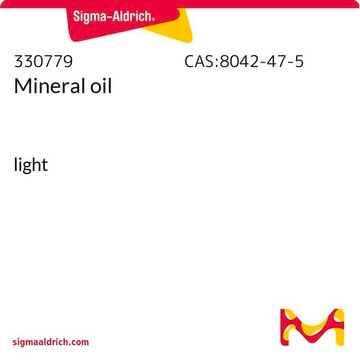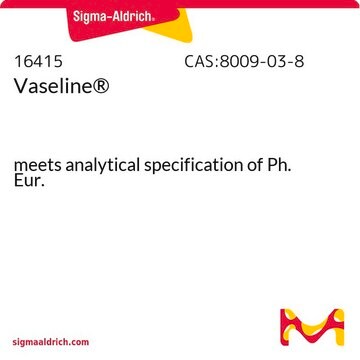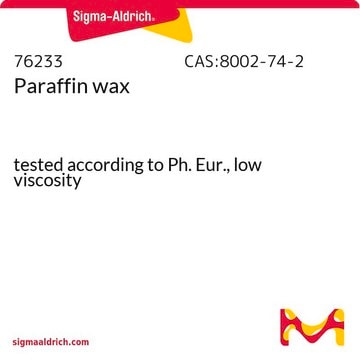76235
Olio di paraffina
suitable for IR spectroscopy
Autenticatiper visualizzare i prezzi riservati alla tua organizzazione & contrattuali
About This Item
Prodotti consigliati
Forma fisica
oil
Livello qualitativo
tecniche
IR spectroscopy: suitable
Indice di rifrazione
n20/D 1.473
Viscosità
100-145 mPa.s(20 °C)
P. eboll.
300 °C (lit.)
Punto di fusione
-24 °C (lit.)
Cerchi prodotti simili? Visita Guida al confronto tra prodotti
Descrizione generale
Paraffin oil resists water. It is widely used as release agent, lubricant, defoamer and also as coating component.
Applicazioni
Paraffin oil has been used in preparation of tyrosinase-modified carbon paste electrode for detection of Catechol.
Avvertenze
Danger
Indicazioni di pericolo
Consigli di prudenza
Classi di pericolo
Asp. Tox. 1
Codice della classe di stoccaggio
10 - Combustible liquids
Classe di pericolosità dell'acqua (WGK)
WGK 2
Punto d’infiammabilità (°F)
419.0 °F - closed cup
Punto d’infiammabilità (°C)
215 °C - closed cup
Dispositivi di protezione individuale
Eyeshields, Gloves, type ABEK (EN14387) respirator filter
Choose from one of the most recent versions:
Possiedi già questo prodotto?
I documenti relativi ai prodotti acquistati recentemente sono disponibili nell’Archivio dei documenti.
I clienti hanno visto anche
Rate-limiting steps of tyrosinase-modified electrodes for the detection of catechol.
Burestedt E
Analytical Chemistry, 68(9), 1605-1611 (1996)
Eryn Slankster et al.
Scientific reports, 10(1), 3119-3119 (2020-02-23)
Starvation enhances olfactory sensitivity that encourage animals to search for food. The molecular mechanisms that enable sensory neurons to remain flexible and adapt to a particular internal state remain poorly understood. Here, we study the roles of GABA and insulin
Jyothi C Abbar et al.
Bioelectrochemistry (Amsterdam, Netherlands), 83, 1-7 (2011-07-26)
The electrochemical oxidation of a hemorheologic drug, pentoxifylline was investigated at a multi-walled carbon nanotubes-paraffin oil paste electrode using cyclic and differential pulse voltammetry. The oxidation process was irreversible over the pH range studied and exhibited an adsorption-controlled behavior. All
Ozlem Yigit et al.
The Journal of emergency medicine, 42(4), 417-419 (2010-12-24)
Fire-eater's pneumonia is a chemical pneumonitis that can develop after accidental aspiration of liquid hydrocarbon-based fuel during a flame-blowing or a fire-eating performance. Typical findings of the patient are similar with any infectious pneumonia: chest pain, shortness of breath, cough
Maria Koliou et al.
European journal of pediatrics, 169(7), 833-838 (2009-12-18)
Information on childhood poisonings in Cyprus is limited. Our objective was to examine the epidemiology of poisonings among children in Cyprus. All children up to 15 years of age admitted for poisoning to the Archbishop Makarios Hospital in Nicosia, Cyprus
Il team dei nostri ricercatori vanta grande esperienza in tutte le aree della ricerca quali Life Science, scienza dei materiali, sintesi chimica, cromatografia, discipline analitiche, ecc..
Contatta l'Assistenza Tecnica.